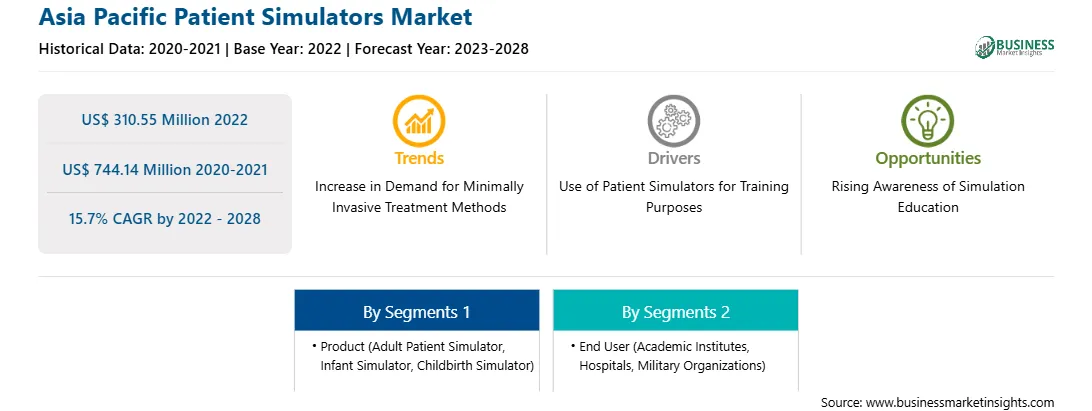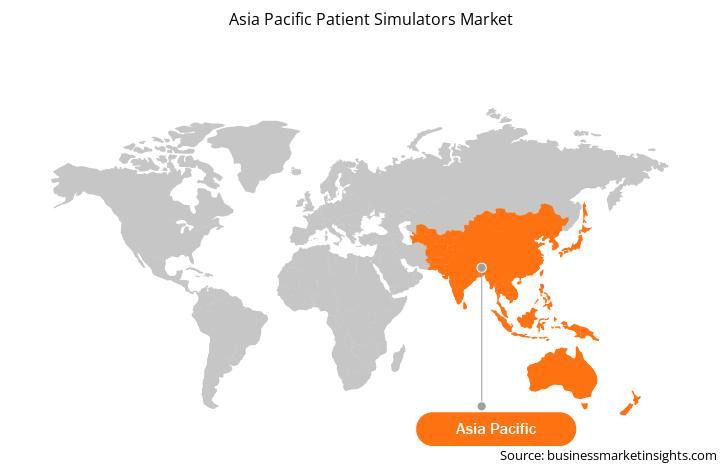亚太地区模拟病人市场预测至 2028 年 - COVID-19 影响和按产品(成人模拟病人、婴儿模拟器和分娩模拟器)和最终用户(学术机构、医院和军事组织)进行的区域分析
No. of Pages: 115 | Report Code: BMIRE00028215 | Category: Life Sciences
No. of Pages: 115 | Report Code: BMIRE00028215 | Category: Life Sciences
微创治疗方法需求的增加推动亚太模拟病人市场增长
微创医疗手术通常是通过将设备穿过皮肤、体腔或解剖开口进入体内来进行的,但对这些结构的损害可能最小。近年来,心血管疾病的治疗取得了显着进步。然而,这些复杂的医疗程序需要丰富的经验和技术专长。在模拟器的帮助下,心血管疾病的复杂治疗变得更加舒适。该系统可以根据患者数据集(包括跳动的心脏)生成真实的 3D 血管模型,并为患者模拟器提供力的实时计算和力反馈模块。机器人手术和患者模拟器都使用机械化界面,提供可视化患者反应以响应医疗保健专业人员的操作,监视器以可视化程序的变化,以及医疗保健专业人员通过其进行交互的计算机软件应用程序。这两种技术正在迅速采用,并被视为允许医生执行日益复杂的微创手术,同时提高患者安全的方式。先进的微创手术(MIS),即机器人辅助手术,正被越来越多的人接受。越来越需要对住院医师进行此类手术的培训。 MIS 需求的不断增长正在推动亚太地区模拟病人市场的增长。
亚太地区模拟病人市场概览< /strong>
亚太地区模拟病人市场分为中国、日本、印度、韩国、澳大利亚和其他地区亚太地区。 2022 年,中国在亚太地区患者模拟器市场占据主导地位。模拟涉及通过适当的场景或设备复制情况或过程的行为,主要用于研究或人员培训。该技术广泛应用于医学教育,以确保患者的安全并培训医疗专业人员。在中国,在COVID-19期间,设计了一个模块,为医务人员提供安全的培训环境,以全面练习他们的感染管理技能。 2021 年 12 月,中国科学家开发了两种感染 COVID-19 的人体模拟模型。来自中国科学院微生物研究所(IMCAS)、清华大学和中国农业大学的研究团队开发了这两个模型,展示了与实际 COVID-19 患者相似的临床特征,以支持未来精准治疗的研究和测试疫苗和药物的功效和安全性。此外,公司不断增加的资金预计将推动该国医疗保健模拟器的增长。
亚太模拟病人市场细分;
亚太地区模拟病人市场根据产品、最终用户和国家/地区。
根据产品,亚太地区模拟病人市场分为成人模拟病人、婴儿模拟器和分娩模拟器。 2022 年,成人模拟病人细分市场占据亚太地区最大的模拟病人市场份额。
根据最终用户,亚太地区模拟病人市场分为学术机构、医院和军事组织。到 2022 年,学术机构细分市场将占据亚太地区最大的模拟病人市场份额。
按国家/地区划分,亚太地区模拟病人市场分为中国、印度、日本、韩国、澳大利亚和亚太其他地区。 2022 年,中国将主导亚太地区模拟病人市场。
CAE Inc、Gaumard Scientific Co Inc、京都化学有限公司、Laerdal Medical AS、肢体和医疗中心Things Ltd、Mentice AB、Simulab Corp、Surgical Science Scotland AB 和 VirtaMed AG 是亚太患者模拟器市场的领先公司。
Strategic insights for Asia Pacific Patient Simulators involve closely monitoring industry trends, consumer behaviours, and competitor actions to identify opportunities for growth. By leveraging data analytics, businesses can anticipate market shifts and make informed decisions that align with evolving customer needs. Understanding these dynamics helps companies adjust their strategies proactively, enhance customer engagement, and strengthen their competitive edge. Building strong relationships with stakeholders and staying agile in response to changes ensures long-term success in any market.

| Report Attribute | Details |
|---|---|
| Market size in 2022 | US$ 310.55 Million |
| Market Size by 2028 | US$ 744.14 Million |
| Global CAGR (2022 - 2028) | 15.7% |
| Historical Data | 2020-2021 |
| Forecast period | 2023-2028 |
| Segments Covered |
By 产品
|
| Regions and Countries Covered | 亚太地区
|
| Market leaders and key company profiles |
The regional scope of Asia Pacific Patient Simulators refers to the geographical area in which a business operates and competes. Understanding regional nuances, such as local consumer preferences, economic conditions, and regulatory environments, is crucial for tailoring strategies to specific markets. Businesses can expand their reach by identifying underserved regions or adapting their offerings to meet regional demands. A clear regional focus allows for more effective resource allocation, targeted marketing, and better positioning against local competitors, ultimately driving growth in those specific areas.

The Asia Pacific Patient Simulators Market is valued at US$ 310.55 Million in 2022, it is projected to reach US$ 744.14 Million by 2028.
As per our report Asia Pacific Patient Simulators Market, the market size is valued at US$ 310.55 Million in 2022, projecting it to reach US$ 744.14 Million by 2028. This translates to a CAGR of approximately 15.7% during the forecast period.
The Asia Pacific Patient Simulators Market report typically cover these key segments-
The historic period, base year, and forecast period can vary slightly depending on the specific market research report. However, for the Asia Pacific Patient Simulators Market report:
The Asia Pacific Patient Simulators Market is populated by several key players, each contributing to its growth and innovation. Some of the major players include:
The Asia Pacific Patient Simulators Market report is valuable for diverse stakeholders, including:
Essentially, anyone involved in or considering involvement in the Asia Pacific Patient Simulators Market value chain can benefit from the information contained in a comprehensive market report.